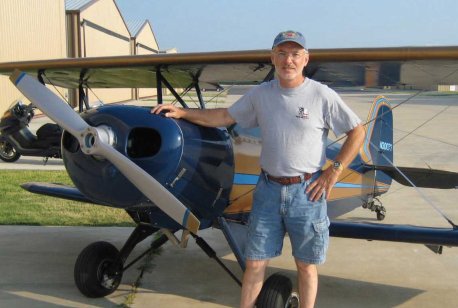Damn Small Biplane
Smith Miniplane DSA-1

Damn Small Biplane or as Frank Smith put it, Damn Small Airplane or DSA-1, the Smith Miniplane. Designed and built in 1956, the Smith Miniplane or as I refer to it, the Smith, took flight in October of that year.
The plane was just as its name sake said, small. Wing span is about 17 feet and length is around 15. The cockpit will "hold" someone up to about 6 feet although you will become very familiar with your knees. The optimum height is probably about 5'8" and about 160 pounds. I am 5'10" and 165 and fit comfortably for short periods of time. I have flown it for as much as an hour with only minor numbing in my butt. If you get a leg cramp you in for some wild aerobatics because there is no such thing as stretching it out.
The Smith was designed as a fairly easy, straight forward to build airplane with aerobatics in mind. The one I fly has an 0-235, the same as the prototype, and will perform entry level aerobatics with no problem. Almost no rudder input is needed in most flying conditions. Easy loops, rolls, hammerheads and the like can be done.
If ever there was a rugged airplane built, its the Smith. And that's a good thing. Landing the Smith is a real addrenaline rush. I have over 200 landings in mine and its still a rush every time. Any rudder input needed on the ground had better be done before its needed. If you wait til you need it, its too late and things go bad fast in a Smith landing.
The final approach in a Smith is kind of like being strapped to a grand piano. What someone kindly called glide doesn't really exist on a Smith. And like all biplanes, once the speed bleeds off a little, the tail drops and visibility over the nose vanishes. Landing with a slip affords the pilot a lot more visibility. Its also usefull to land at a faster approach than you would normally do. I come in at times as high as 80mph which gives more control and visibility over the nose. Of all the planes I've flown, non lands with as much excitment as the Smith.
the specifications of the Smith are as follows:
Upper Wing Span 17 ft.
Lower Wing Span 15 ft. 9 in.
Length 15 ft. 1 in.
Height 5 ft.
Empty Weight 616 lbs.
Gross Weight 1000 lbs.
Maximum Speed 125 mph
Cruise Speed 117 mph
Landing Speed 50 mph
Range 300 mi.
These specs are from the EAA Museum website. You will notice that it qualifies as a light sport aircraft. That does not and I want to emphasize, not make it an easy or docile aircraft for the inexperienced pilot. With some training anyone can fly it but it does not "fly like a Cub". Get plenty of tailwheel time and then spend a few weeks doing high speed taxis with the tail up. I'm not trying to talk you out of one, just want you to be aware now of what to expect.
Its a Damn Small Biplane with lots of big excitment!
Damn Small Biplane top of page